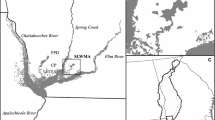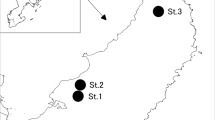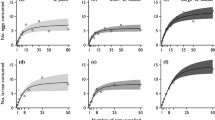Abstract
Oviposition of non-calcareous or thinly shelled eggs represents an important life stage of many insects, amphibians, and several gastropods. A recently identified invasive species of apple snail, Pomacea insularum, exhibits alarming invasive characteristics of high reproductive rates and generalist consumption patterns. This snail takes the opposite approach to egg laying compared to most aquatic insects as adult snails crawl out of the water to place clutches on emergent, or terrestrial, substrates. As fecundity best indicates invasive potential for mollusks, control or management efforts need to understand reproductive behavior in P. insularum to predict, and hopefully impede, its spread throughout the Gulf Coast of the United States. Specific characteristics of wetlands and shallow lakes may facilitate the invasion process of P. insularum by providing females with conditions that permit successful oviposition. In order to investigate this possibility, we studied P. insularum oviposition behavior in an invasive population at two times during the reproductive season in Texas, USA. Based on a subsequent survey (August 2009), plants comprised 78% of the available habitat. Wild taro (Colocasia esculenta) and alligator weed (Alternanthera philoxeroides) represented 48 and 43% of that proportion, respectively. During 2008–2009, no new concrete or metal structures appeared in our sampling reach and consistent amounts of plant stands and woody debris remained dominant. Given this distribution, P. insularum laid disproportionately more clutches on wild taro compared to its availability and less on alligator weed and bulrush (Schoenoplectus californicus) than expected. Owing to limited metal and concrete substrates, we found a higher proportion of clutches on these artificial substrates than expected in both May and August 2008. However, artificial substrates comprised less than 2% of available substrates in the bayou. Our results suggest that wetlands and shallow lakes surrounded by large emergent macrophytes, particularly wild taro, likely provide ideal oviposition sites for P. insularum, promote egg supply, and possibly facilitate invasion into new aquatic ecosystems.



Similar content being viewed by others
References
Akridge, R. E. & P. J. Fonteyn, 1981. Naturalization of Colocasia esculenta (Araceae) in the San Marcos River, Texas. The Southwestern Naturalist 26: 210–211.
Barnes, M., R. Fordham, R. Burks & J. J. Hand, 2008. Fecundity of the exotic apple snail, Pomacea insularum. Journal of North American Benthological Society 27: 738–745.
Burlakova, L. E., A. Y. Karatayev, D. K. Padilla, L. D. Cartwright & D. N. Hollas, 2008. Wetland restoration and invasive species: applesnail (Pomacea insularum) feeding on native and invasive aquatic plants. Restoration Ecology 17: 433–440.
Byers, J. E., 2002. Impact of non-indigenous species on natives enhanced by anthropogenic alteration of selection regimes. Oikos 97: 449–458.
Conner, S. L., C. M. Pomory & P. C. Darby, 2008. Density effects of native and exotic snails on growth in juvenile apple snails Pomacea paludosa (Gastropoda: Ampullariidae): a laboratory experiment. Journal of Molluscan Studies 74: 355–362.
Dana, P. & C. C. Appleton, 2007. Observations on the population dynamics of the invasive freshwater snail Aplexa marmorata (Pulmonata: Physidae) in Durban, South Africa. South African Journal of Science 103: 493–496.
Dreon, M. S., S. Ituarte, M. Ceolin & H. Heras, 2008. Global shape and pH stability of ovorubin, an oligomeric protein from the eggs of Pomacea canaliculata. Federation of European Biochemical Societies 18: 4522–4530.
Ellis, A. M., 2008a. Incorporating density dependence into the oviposition preference–offspring performance hypothesis. Journal of Animal Ecology 77: 247–256.
Ellis, A. M., 2008b. Linking movement and oviposition behaviour to spatial population distribution in the tree hole mosquito Ochlerotatus triseriatus. Journal of Animal Ecology 77: 156–166.
Gibbons, J. W., 2003. Terrestrial habitat: a vital component for herpetofauna of isolated wetlands. Wetlands 23: 630–635.
Havel, J., B. Jonathan, B. Shurin & R. Jones, 2002. Estimating dispersal from patterns of spread: spatial and local control of lake invasions. Ecology 83: 3306–3318.
Hayes, K. A., R. C. Joshi, S. C. Thiengo & R. H. Cowie, 2008. Out of South America: multiple origins of non-native apple snails in Asia. Diversity and Distributions 14: 701–712.
Hirayama, H. & E. Kasuya, 2008. Factors affecting submerged oviposition in a water strider: level of dissolved oxygen and male presence. Animal Behaviour 76: 1919–1926.
Horn, K. C., S. D. Johnson, K. M. Boles, A. Moore, E. Siemann & C. A. Gabler, 2008. Factors affecting hatching success of golden apple snail eggs: effects of water immersion and cannibalism. Wetlands 28: 544–549.
Howells, R. G., L. E. Burlakova, A. Y. Karatayev, R. K. Marfurt & R. L. Burks, 2006. Native and introduced Ampullariidae in North America: history, status, and ecology. In Joshi, R. & L. Sebastian (eds), Global Advancements in Ecology and Management of Golden Apple Snails. Philippine Rice Research Institute, Nueva Ecija, Philippines: 73–112.
Kaufman, S. R. & W. Kaufman, 2007. Invasive Plants: guide to identification and the impacts and control of common North American species. Stackpole Books, Mechanicsburg, PA.
Keller, R., J. Drake & D. Lodge, 2007. Fecundity as a basis for risk assessment of nonindigenous freshwater mollusks. Conservation Biology 21: 191–200.
Lancaster, J., P. Downes & P. Reich, 2003. Linking landscape patterns of resource distribution with models of aggregation in ovipositing stream. Journal of Animal Ecology 72: 969–978.
Lockwood, J. L., P. Cassey & T. Blackburn, 2005. The role of propagule pressure in explaining species invasions. Trends in Ecology and Evolution 20: 223–228.
Peña, S. C. & G. N. Pocsidio, 2007. Influence of copper on the feeding rate, growth and reproduction of the golden apple snail, Pomacea canaliculata Lamarck. Bulletin of Environmental Contamination and Toxicology 79: 606–608.
Pizani, N. V., A. L. Estebenet & P. R. Martín, 2005. Effects of submersion and aerial exposure on clutches and hatchlings of Pomacea canaliculata (Gastropoda: Ampullariidae). American Malacological Bulletin 20: 55–63.
Qiu, J. W. & K. L. Kwong, 2009. Effects of macrophytes on feeding and life history traits of the invasive apple snail (Pomacea canaliculata). Freshwater Biology 54: 1720–1730.
Rawlings, T., K. Hayes, R. Cowie & T. Collins, 2007. The identity, distribution, and impacts of non-native apple snails in the continental United States. BMC Evolutionary Biology 7: 97–111.
Resetarits, W. J. Jr., 1996. Oviposition site choice and life history evolution. American Zoologist 36: 205–215.
Rogevich, E. C., T. C. Hoang & G. M. Rand, 2009. Effects of sublethal chronic copper exposure on the growth and reproductive success of the Florida apple snail (Pomacea paludosa). Archives of Environmental Contamination and Toxicology 56: 450–458.
Simberloff, D., 2006. Invasional meltdown 6 years later: important phenomenon, unfortunate metaphor, or both? Ecology Letters 9: 912–919.
Turner, R. L., 1998. Effects of submergence on embryonic survival and developmental rate of the Florida applesnail, Pomacea paludosa: implications for egg predation and marsh management. Florida Scientist 61: 118–129.
USDA, 2009. Profile for Colocasia esculenta (coco yam). In: Plants Database. United States Department of Agriculture. Available via DIALOG. http://plants.usda.gov/java/profile?symbol=COES. Accessed 9 March 2009.
Van Dyke, J., 2009a. Snail Busters: Save the Glades! http://snailbusters.wordpress.com/. Accessed 18 March 2009.
Van Dyke, J., 2009b. Snail Busters: Recipe for Success. http://snailbusters.wordpress.com/. Accessed 14 February 2009.
Van Dyke, J., 2009c. Snail Busters: Aloha, Poi? http://snailbusters.wordpress.com/. Accessed 22 May 2009.
Acknowledgments
We thank the Texas Academy of Sciences, Southwestern University and H-E-B for providing us with research funding. James McDonough and Alexis Kropf helped us in our field work. We remain grateful to Jill Lancaster for stimulating our thinking about oviposition. Jo Latimore provided helpful comments on our draft manuscript. Our gratitude also goes to Mark Kramer, Ann Brinly, George Regmond, and the entire staff at Armand Bayou Nature Center. We would also like to credit Rebecca Marfurt, Sarah Hensley, Matt Barnes, Abby Youens, and Brandon Boland for providing initial life history data for P. insularum. We remain indebted to Megan Rice, Katie Gibson, Olivia Stanzer, Scott Manusov, Vanessa Toro, and Brandon O’Connor for counting thousands of eggs.
Author information
Authors and Affiliations
Corresponding author
Additional information
Guest editors: M. Meerhoff, M. Beklioglu, R. Burks, F. García-Rodríguez, N. Mazzeo & B. Moss / Structure and Function of World Shallow Lakes: Proceedings from the 6th Shallow Lakes Congress, held in Punta del Este, Uruguay, 23–28 November, 2008
Rights and permissions
About this article
Cite this article
Burks, R.L., Kyle, C.H. & Trawick, M.K. Pink eggs and snails: field oviposition patterns of an invasive snail, Pomacea insularum, indicate a preference for an invasive macrophyte. Hydrobiologia 646, 243–251 (2010). https://doi.org/10.1007/s10750-010-0167-1
Published:
Issue Date:
DOI: https://doi.org/10.1007/s10750-010-0167-1




